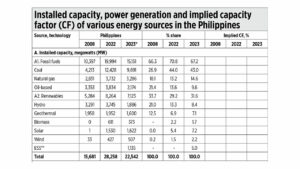Top 10 news stories on power and electricity of 2023

For this column, here are the top 10 power and electricity news stories of 2023.
1. Philippine power generation is back to a yearly increase of five terawatt-hours (TWH) after a big decline during the 2020 lockdown dictatorship. In 2022, generation reached 111.5 TWH or 111,500 gigawatt-hours (GWH), according to the power statistics released by the Department of Energy (DoE) in mid-2023. This is almost double the 60.8 TWH in 2008 when the Renewable Energy (RE) Act or RA 9513 was enacted. According to the 2023 data from the Independent Electricity Market Operator of the Philippines (IEMOP), the Luzon and Visayas grids have produced 75.4 TWH for April-November alone.
2. Of the 111.5 TWH generated in 2022, 60% of it came from coal plants, 16% from (Malampaya) natural gas, and 9% each from geothermal and hydro. Solar and wind combined contributed only 2.5% of total, this after 14 years of political favoritism, fiscal incentives and tax exemptions, and energy mandates.
3. Coal was tops when considering the implied capacity factor, which is the ratio or percent of actual electricity generated by a given energy source in a given year, measured as: Capacity factor for the year (in %) = Generation in TWH/(installed capacity in MW x 24 hours/day x 365 days/year). Coal had 61%, natgas had about 50%, wind had about 23%, and solar had only 14%, which is very low and inefficient (see the table).
Items four to 10 were selected reports from BusinessWorld and mostly written by Sheldeen Joy Talavera:
4. The expansion of energy reserves and power capacity as seen in these reports: “DoE to resume certification of projects for expedited permits” (Nov. 6), “Malampaya exploration raises prospect of gas supply expansion, BMI says” (Nov. 9), “PHL coal, oil reserves valuation rises sharply as gas dwindles” (Nov. 23). We should have continuously expanding oil, gas and coal reserves via endless exploration and drilling. As shown in the table, fossil fuels contribute about 79% of total power generation in the country. A reduction in their share with no significant increase from non-fossil fuel sources would mean regular, wide-ranging blackouts in the country.
5. The endless lobbying for power de-generation, deindustrialization and degrowth economics: “Coal power phaseout by 2035, gas by 2040 deemed feasible” (Nov. 15), “ACEN, partners to retire coal plant in the Philippines” (Dec. 5), “DoE calls for accelerated retirement, repurposing of coal-fired power plants” (Dec. 6), “USAID helping PHL regulator effect clean energy transition” (Dec. 10), “Gov’t urged to develop timeline to retire coal-fired power plants” (Dec. 10).
As discussed above, coal is the main workhorse for power generation. It is why even climate and RE activists have 24/7 electricity, and yet coal is the most demonized energy source. The double talk is like when tens of thousands of climate leaders who demonize fossil fuels use lots of fossil fuels to fly from all around the world to the UN’s Conference of Parties (COP) annual meetings.
6. There have been good moves towards nuclear power development in the Philippines: “US, Philippines ink landmark deal on nuclear cooperation” (Nov. 17), “Nuclear deal seen addressing PHL need for baseload power” (Nov. 19), “House approves bill creating nuclear regulator” (Nov. 22).
At least two big generation companies, MGen and Aboitiz Power, have made explicit advocacies to develop nuclear energy in the future. Good move, guys.
7. The National Grid Corp. of the Philippines (NGCP) continues to be behind schedule in their transmission development projects in the country: “System impact studies approved for 32,000 MW worth of power projects” (Nov. 14), “NGCP seeks resolution of TRO on Panay-Guimaras tower sites” (Nov. 30), “NGCP sees Cebu-Bohol 230-kV link project completed in 2024” (Dec. 5).
8. News on energy pricing and regulations: “ERC caps NGCP allowable revenue at P36.7B annually, well below amount sought by grid” (Nov. 8), “ERC integrates with energy one-stop shop system” (Dec. 13), “Spot power prices fall in early Dec.” (Dec. 14).
The ERC, or Energy Regulatory Commission, is also reviewing the secondary price cap or price control at the wholesale electricity spot market (WESM). I hope that the ERC moves to abolish all forms of price controls there. The most expensive electricity is no electricity — blackouts — and the resulting damaged production, appliances, and inconvenience to people and businesses. If the spot price can jump to, say, P40/kWh for three hours due to transmission or generation problems and blackouts of three hours are avoided, then that is worth it. The average price can go down later.
9. Stories on Meralco being the largest electricity distributor in the Philippines: “Meralco baseload bid attracts interest from power providers with 3,000 MW in capacity” (Nov. 21), “Meralco starts bidding for 1,200-MW power supply” (Dec. 1). Securing huge power supply contracts from huge new power plants to ensure medium to long-term power security and stability are good moves by Meralco. Meralco’s electricity sales growth generally mirrors overall GDP growth. In Q1-Q3 2023, Meralco sales growth was 4.4%, not far from the overall GDP growth of 5.6% over the same period.
10. The DoE created an Energy Efficiency Excellence (EEE) Award for LGUs. The province of Iloilo was ranked the highest, and they will be rewarded by the DoE at the Hilton Hotel on Dec. 19. Iloilo Provincial Board Member Rolando Distura will receive the award on behalf of the Iloilo Provincial government. Mr. Distura was a former Mayor of Dumangas municipality and was one of our wedding godfathers when I got married in Iloilo City in 2005. Congratulations, Ninong.
We should prioritize energy realism, not alarmism. We should prioritize sustained economic growth, wealth creation and job creation for our people, not ecological central planning, not climate-related restrictions, taxation, and regulations.
Bienvenido S. Oplas, Jr. is the president of Bienvenido S. Oplas, Jr. Research Consultancy Services, and Minimal Government Thinkers. He is an international fellow of the Tholos Foundation.




